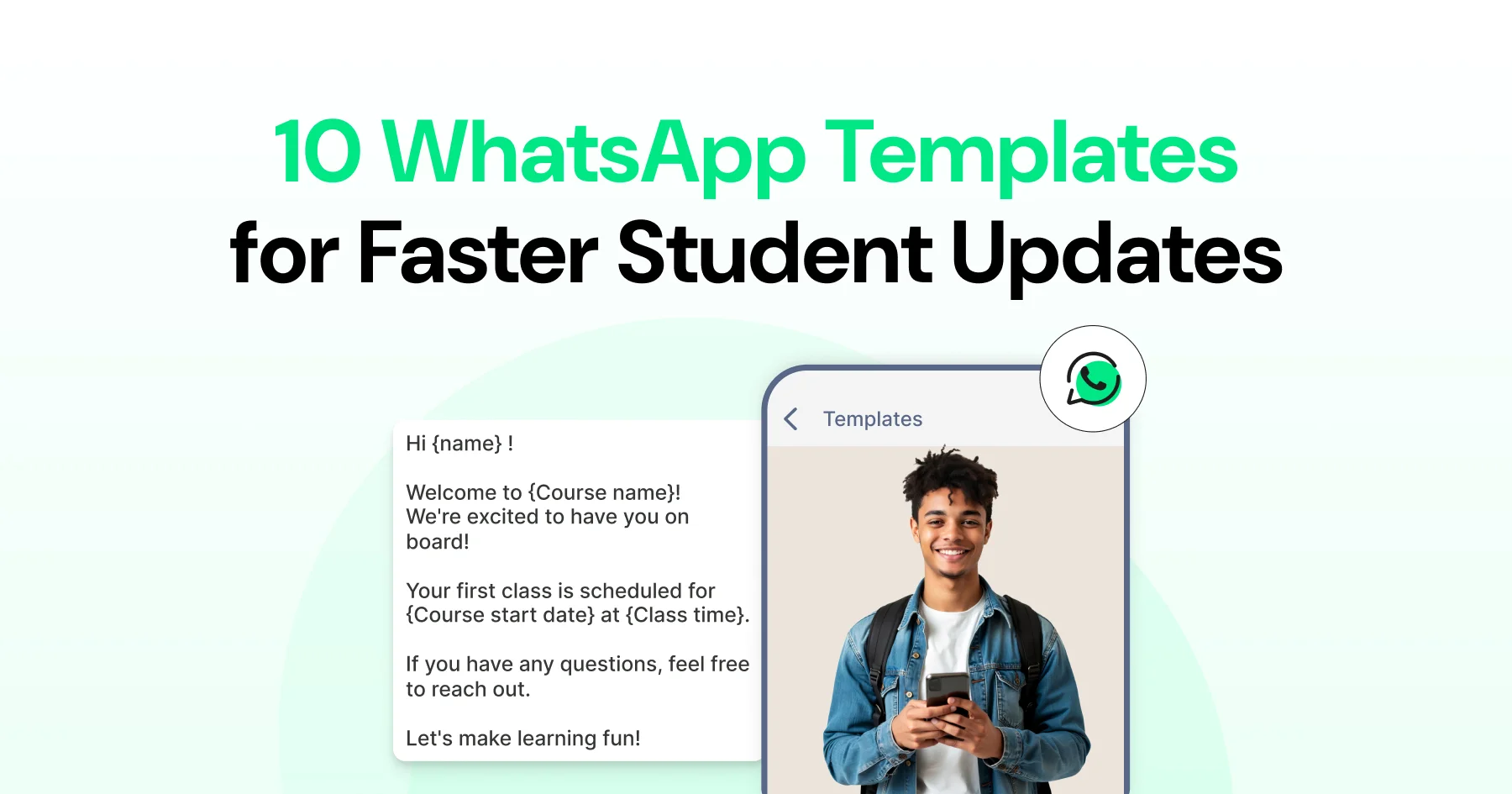
10 WhatsApp Message Templates for Tuition Classes to Save Time and Boost Engagement
Written by:
 Rohan
|
on:
September 30, 2025
|
Last updated on:
October 1, 2025
|
According to: Editorial Policies
Rohan
|
on:
September 30, 2025
|
Last updated on:
October 1, 2025
|
According to: Editorial Policies
Too Long? Read This First
- WhatsApp messages for tuition classes help businesses stay organized and keep students and parents informed in real time.
- Using ready-to-send templates saves time on repetitive communication like reminders, homework updates, and class announcements.
- Timely updates, multimedia content, and interactive messages improve student engagement beyond the classroom.
- Maintaining a professional yet friendly tone helps build credibility while keeping messages approachable.
- WhatsApp automation tools like Wati make it easy to schedule reminders, broadcast messages, and handle 1:1 chats efficiently.
For tuition centers, keeping students engaged often comes down to how effectively you communicate. For fast and easy communication, nothing works better than WhatsApp. It’s familiar and always within reach.
A well-timed WhatsApp message for tuition classes can help you boost attendance, share updates instantly, and build stronger connections with both students and parents.
The best part is that you don’t need to draft messages from scratch every time. In this guide, we’ve curated 10 ready-to-use WhatsApp templates that make communication easier, more professional, and more impactful.
This allows you to focus on teaching while WhatsApp helps deliver messages effectively, creating a smoother learning experience for students.
How Can You Use WhatsApp Messages for Tuition Class
Papers and printed materials are difficult to handle and carry, especially when technology offers smoother options. Since every parent and student already has WhatsApp on their phone, it becomes the easiest way to communicate.
Plus, WhatsApp is used everywhere, making it a natural choice for engagement. High open rates, instant delivery, and a familiar interface ensure your messages get seen and acted upon.
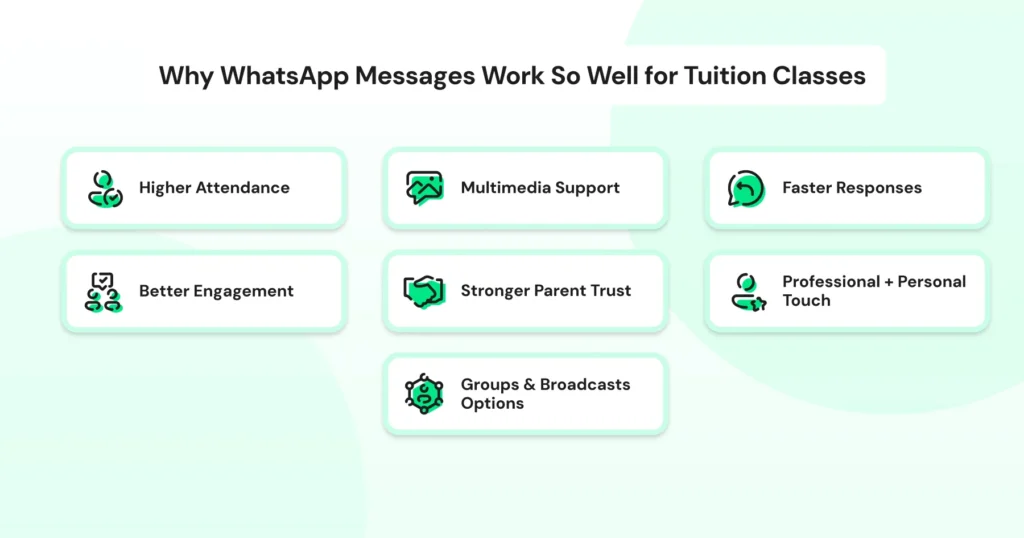
For you, this means fewer missed classes, better-prepared students, and stronger trust with parents through a channel they already use every day.
Here are some key benefits of using WhatsApp for your tuition classes communication.
- Higher attendance: Timely reminders ensure students show up on time and prepared.
- Better engagement: Quick updates and shared resources keep students involved beyond the classroom.
- Multimedia support: Share videos, PDFs, images, or voice notes to make lessons interactive and effective.
- Stronger parent trust: Consistent communication builds confidence with parents about progress.
- Faster responses: Students can clarify doubts or confirm schedules instantly via WhatsApp.
- Professional yet personal touch: Messages remain approachable while maintaining a business-like tone.
- Group & broadcast options: Run discussions in groups or share one-to-many updates via broadcasts without clutter.
✅Related Read: WhatsApp Broadcast vs WhatsApp Group
How WhatsApp Message Templates Simplify Tuition Communication
Managing tuition class communication isn’t always easy. You’re handling schedules, updates, reminders, and parent queries all at once. That is where WhatsApp message templates for tuition classes can make a big difference.
They keep your communication consistent, professional, and efficient, without adding to your workload. Here’s how templates help streamline your workflow.
1. Streamline Communication
Pre-designed templates mean you’re never starting from scratch. You can send clear, consistent messages from schedules to exam updates in seconds.
2. Save Time
Routine updates like attendance or homework reminders become quick edits instead of full rewrites, giving you more time to focus on teaching.
3. Maintain Professionalism
WhatsApp message for tuition classes template ensures every message is polished and reliable, building trust with parents and showing students you take communication seriously.
4. Reduce Errors
With structured templates, you avoid missing key details, keeping your updates accurate and error-free.
5. Encourage Faster Responses
Clear, action-driven wording prompts quicker replies, whether it’s confirming schedules or addressing fee reminders.
10 WhatsApp Message Templates to Boost Student Engagement
Here’s a ready-to-use set of WhatsApp messages for tuition classes designed to save you time and keep students engaged.
Each template serves a specific purpose, helping you communicate clearly, consistently, and professionally without the extra effort.
1. Welcome WhatsApp Message for New Students
Start on the right note by sending a warm welcome message. Use this template to introduce new students to your tuition class, provide essential details, and set expectations. A friendly first impression helps establish trust and sets the foundation for a productive learning relationship.
Hi [Student Name]! 🎉
Welcome to [Tuition Class Name]!
We’re excited to have you on board.
Your first class is scheduled for [Date, Time].
If you have any questions, feel free to reach out.
Let’s make learning fun!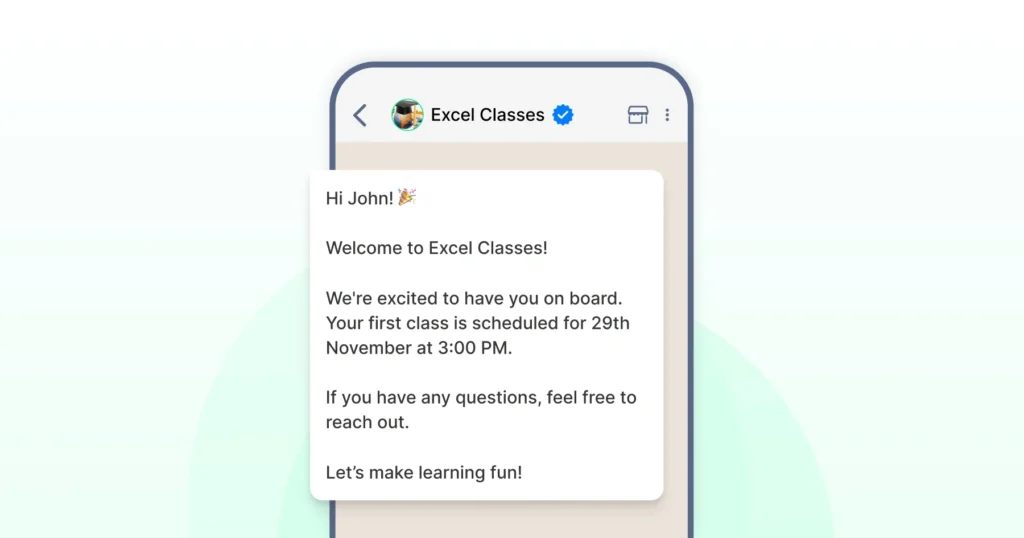
2. Class Schedule Updates
Once students are on board, keeping them informed is key. Regular reminders help prevent confusion, ensure punctuality, and make sure students and parents are always on the same page. Consistency here improves attendance and engagement.
Hello [Student Name]/Parents, this is a reminder about the upcoming class:
🗓 Date: [Date]
⏰ Time: [Time]
📍 Location: [Venue/Online Link]
Please be on time. See you soon!
[Tuition Class Name]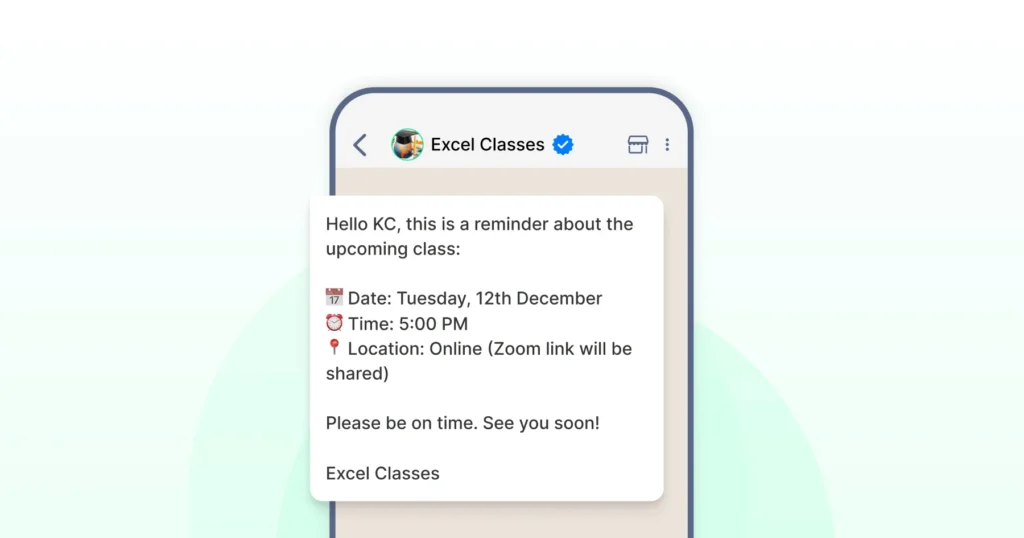
3. Attendance Reminders
Alongside the above, attendance reminders act as gentle nudges, showing students you care about their consistency and helping them stay on track.
Sending a quick reminder before each class shows students you care about their learning journey and reinforces the habit of being punctual and prepared.
Good morning [Student Name]
Just a quick reminder that today’s class starts at [Time].
Don’t forget to bring your materials.
Let’s have a productive session!
[Tuition Class Name]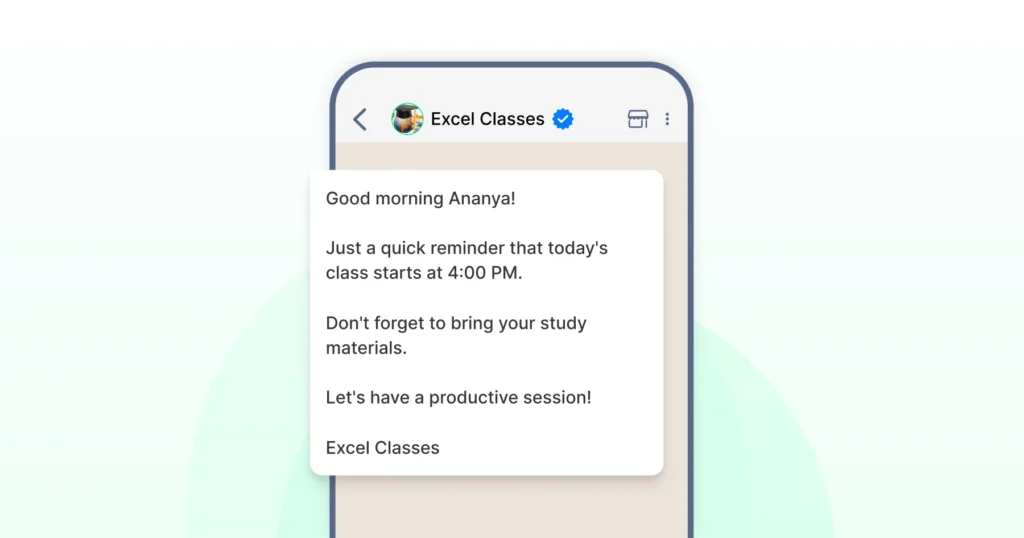
4. Homework or Assignment Notifications
Share homework details directly via WhatsApp to ensure students never miss an assignment. This approach keeps both students and parents informed, reduces missed submissions, and supports better learning outcomes.
Hi [Student Name], here’s your homework for today: [Brief Details].
Please complete it by [Due Date]
If you need help, let me know!
[Tuition Class Name]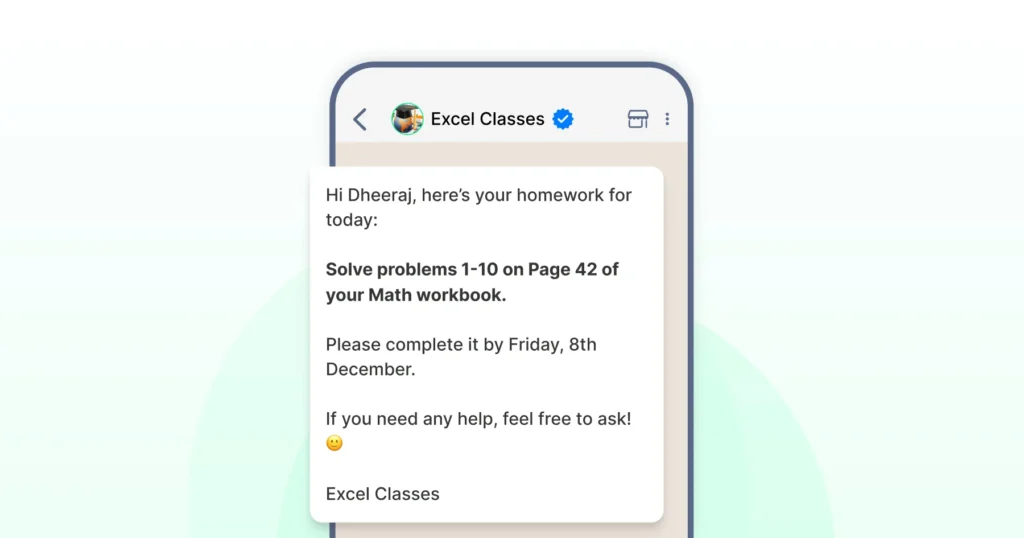
5. Exam Preparation Tips
This WhatsApp message for tuition classes is to help students stay on top of their studies by sending quick tips, motivational messages, or valuable resources.
These thoughtful nudges not only guide their preparation but also show your commitment to their success.
Hi [Student Name], exams are around the corner! 📚
Here’s a quick tip: [Insert Tip].
Remember, consistency is key.
Let me know if you need any extra help!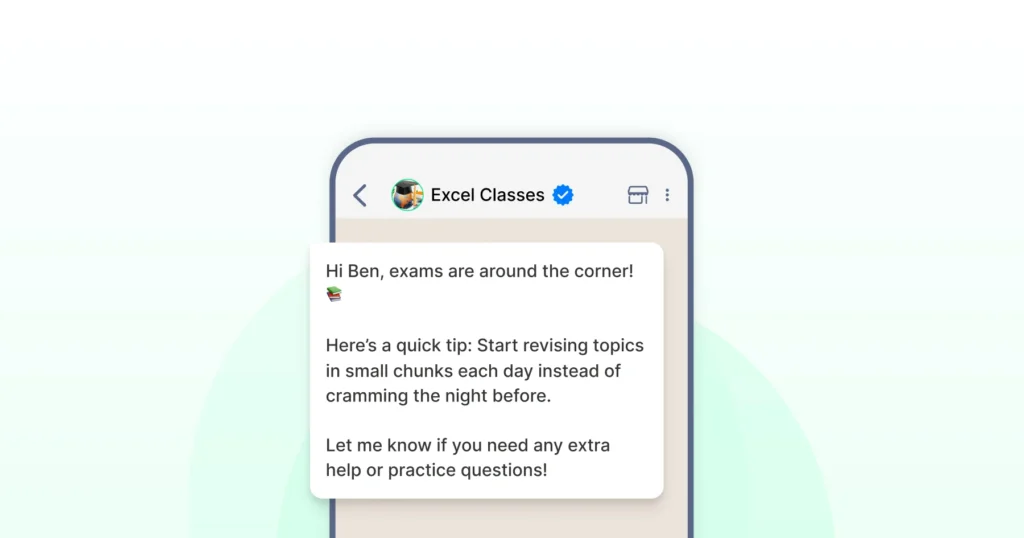
6. Fee Payment Reminders
Financial matters also require attention. Fee payment reminders through this template provide a polite and professional way to keep parents informed, ensuring smooth collections without awkward conversations.
Dear [Parent Name], this is a friendly reminder that the tuition fee of [Amount] for [Student Name] is due on [Date].
Please feel free to contact us if you have any questions regarding payment methods.
Thank you!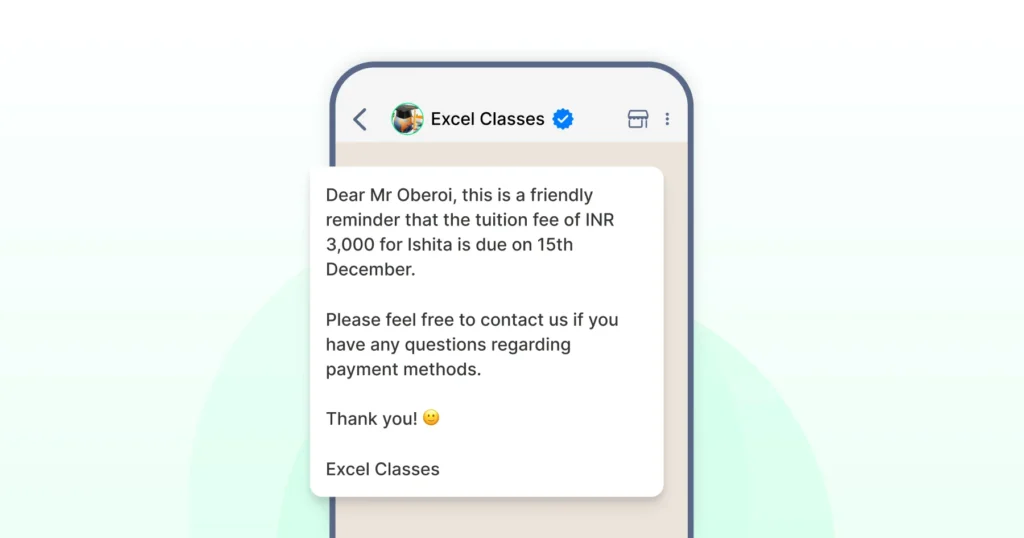
7. Holiday or Break Announcements
This template helps you notify students and parents about upcoming holidays or breaks in advance. Clear communication, including resumption dates, helps everyone plan ahead and maintains a sense of structure in your tuition program.
Hello! 😊
Just letting you know that there will be no classes from [Start Date] to [End Date] due to [Reason].
Classes will resume on [Resumption Date].
Enjoy your break!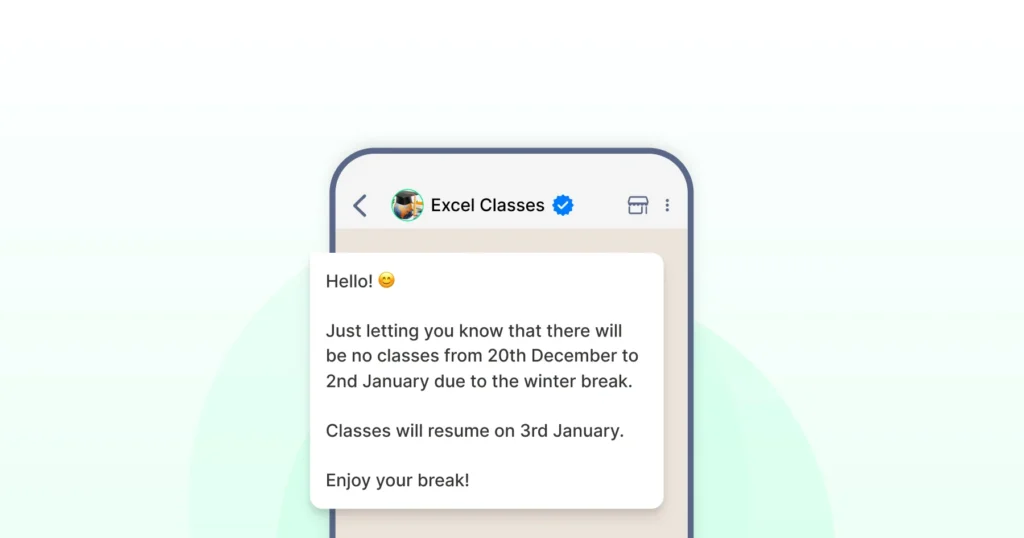
8. Parent-Teacher Meeting Invitations
Engagement goes beyond logistics. Inviting parents to parent-teacher meetings fosters collaboration and ensures students’ progress is supported both at home and in class.
Dear [Parent Name], we’re hosting a Parent-Teacher Meeting on [Date] at [Time].
This is a great opportunity to discuss [Student Name] ’s progress and address any concerns.
Looking forward to seeing you! 😃
[Tuition Class Name]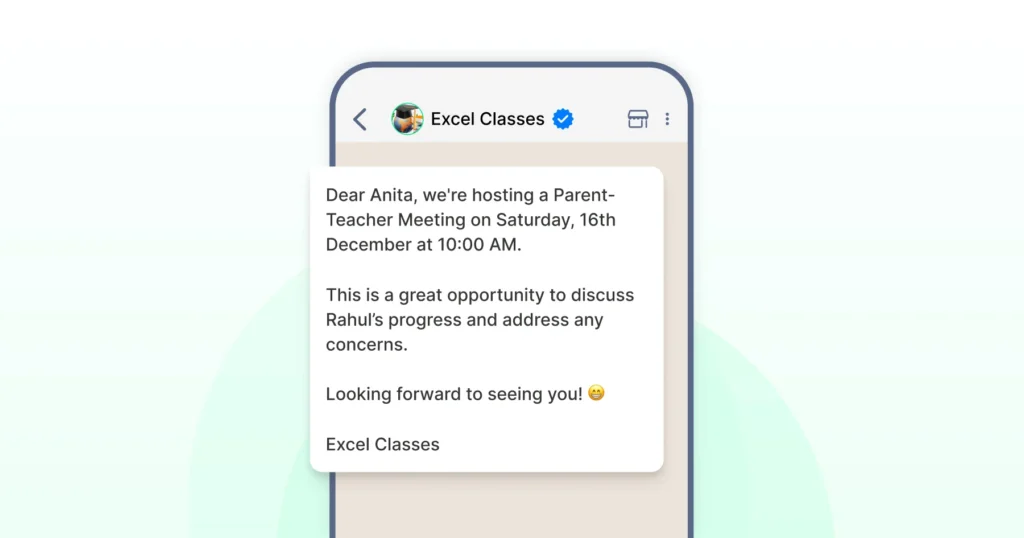
9. Motivational Messages for Students
Another thing you can do with WhatsApp is keep students inspired and focused with encouraging messages. Small gestures like these boost morale, especially during exam season, and help foster a supportive learning environment.
Hi [Student Name]! 🌟 Just a little reminder that every effort you put in counts.
Keep up the great work, and don’t hesitate to reach out if you need support.
You’ve got this! 👊
[Tuition Class Name]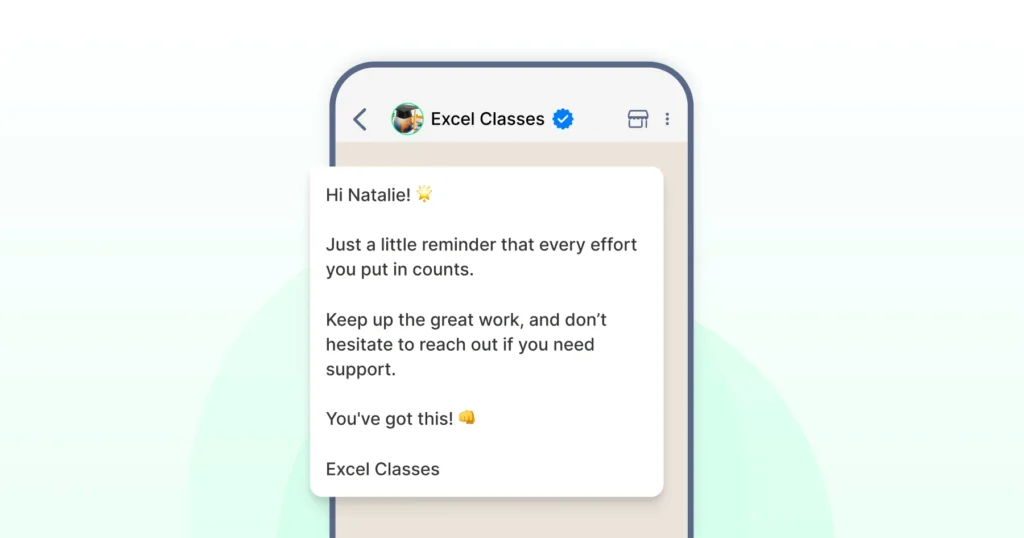
10. Class Completion or Progress Updates
Finally, sharing class completion or progress updates celebrates milestones, motivates students, and reassures parents of the value your tuition program provides.
Hello [Parent Name], we’re happy to share that [Student Name] has completed [Milestone, e.g., ‘Chapter 3 on Algebra’]
They’ve been doing great.
Thank you for your continued support!
[Tuition Class Name]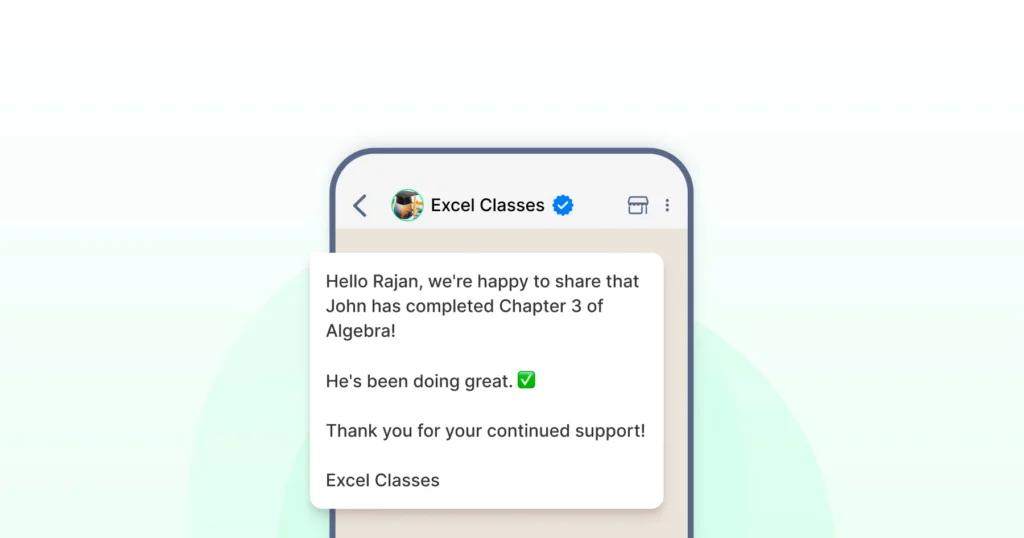
Tips to Write an Effective WhatsApp Message for Tuition Classes
By now, you’ve seen how different message templates can simplify communication and boost engagement. However, WhatsApp templates work best when paired with the right writing style.
After all, how you frame your WhatsApp messages can make the difference between a quick response and a missed update.
Here are some simple yet powerful tips to make your messages clear, engaging, and professional.
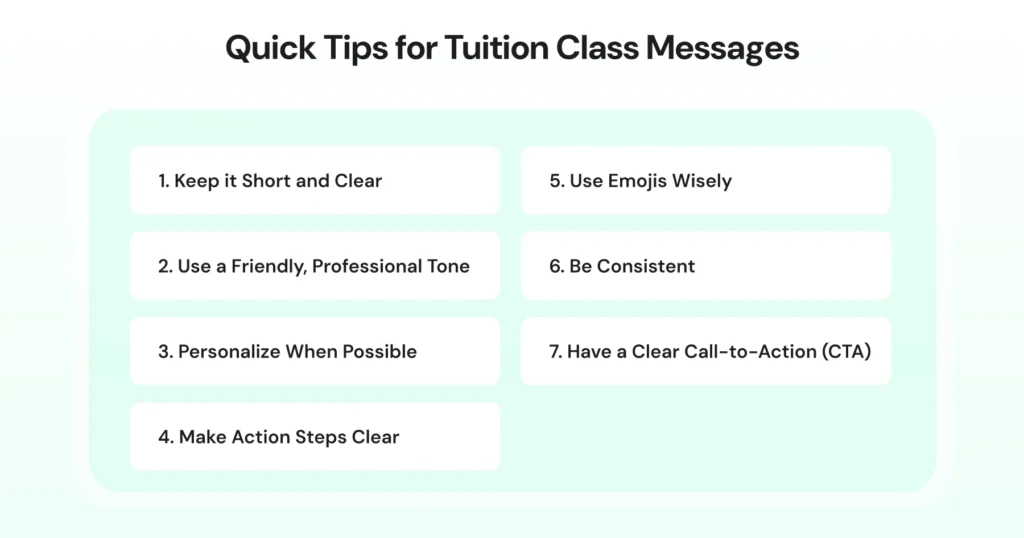
1. Keep it Short and Clear
Long messages can easily overwhelm students and parents, making it less likely that key details are read or remembered. Focus on one main point per message, and structure your text so it’s easy to scan. Short, clear messages save time for both you and the recipient while improving engagement.
Example:
Instead of writing a long paragraph about tomorrow’s class, say:
“Reminder: Tomorrow’s class starts at 5 PM. Please bring your math workbook.”
2. Use a Friendly, Professional Tone
The tone of your messages reflects your brand and professionalism. Striking the right balance between warmth and clarity is key. Messages that are too formal can feel distant, while overly casual ones may reduce credibility. A professional but approachable tone builds trust and encourages timely responses.
Example:
✔️ “Hi Ananya, great job on completing your assignment! Looking forward to seeing you tomorrow at 6 PM.”
3. Personalize When Possible
Personalization goes a long way in showing that you value each student. Including names, specific achievements, or class details makes the message feel tailored rather than generic. This small effort can significantly improve engagement and rapport.
Example:
“Hi John, congratulations on finishing Chapter 5! We’ll start Chapter 6 in tomorrow’s class at 4 PM.”
4. Make Action Steps Clear
If you want students or parents to take action, such as attending a meeting, submitting homework, or reviewing a resource, state it explicitly. Clear instructions reduce confusion, improve compliance, and ensure that your message achieves its intended purpose.
Example:
“Please submit your assignment by Friday, Sept 22. Share it here on WhatsApp or bring it to class.”
5. Use Emojis Wisely
Emojis add a friendly, approachable touch and make messages more visually engaging. However, too many can distract from the message or appear unprofessional. Stick to 1–2 relevant emojis that complement the content.
Example:
“Reminder: Science class at 3 PM today 🔬. Don’t forget your notes 📖.”
6. Be Consistent
Consistency builds trust and sets clear expectations. Use a standardized style for your messages, and stick to regular timings for reminders and updates. When students and parents know what to expect, it improves responsiveness and reduces confusion.
Note: Always send class reminders the night before and homework details right after class ends.
7. Have a Clear Call-to-Action (CTA)
Every message should guide the recipient toward the next step. A clear CTA ensures that your audience knows exactly what to do, which can improve participation, homework submission, or meeting attendance.
Example:
“Please confirm your availability for the Parent-Teacher Meeting,” or “Let us know if you have any questions.”
Best Practices for Sending a WhatsApp Message for Tuition Classes
Crafting a great message is just the first step. How and when you send it can make all the difference. Follow these best practices to ensure your messages reach the right people, at the right time, and in the right way.
1. Time it Right
Send messages when parents and students are most likely to check their phones, such as mornings or early evenings. Avoid late-night messages to respect personal time.
2. Use a Clear Opening
You can also try starting with a short, direct line that signals the purpose, like “Class Reminder” or “Homework Update.” This grabs attention instantly and reduces confusion.
3. Use Groups and Broadcasts Strategically
Groups are ideal for class discussions, while WhatsApp broadcasts work best for announcements. This keeps communication organized and prevents unnecessary clutter.
4. Proofread Before Sending
Double-check details, links, and attachments before hitting send. Accurate messages save follow-ups and show your attention to detail.
5. Protect Privacy
Share sensitive information, such as fees or individual student progress, via private messages rather than in group chats.
6. Stick to a Consistent Frequency
Maintain a reasonable messaging schedule. Avoid overwhelming recipients as regular, concise updates are far more effective than frequent, scattered messages.
7. Add Visuals When Relevant
Images, PDFs, or short videos can make messages more engaging. For example, include study material, class highlights, or important announcements.
8. Maintain Professionalism in Delivery
Even casual reminders should remain polite and respectful. This helps strengthen trust and keeps communication smooth.
After understanding how to craft effective messages and follow best practices, the next step for tuition centers is streamlining communication. Handling multiple students, parents, and prospects manually can be time-consuming and prone to errors. This is where the right tool can make a significant difference.
How Wati Can Help Streamline WhatsApp Communication for Tuition Classes
Managing communication with students, parents, and prospects can be time-consuming, but Wati simplifies it all.
- Automated Reminders: Ensure students never miss a class, homework deadline, or exam alert.
- Broadcast Messages & Lists: Reach multiple recipients at once while maintaining privacy, ideal for updates, announcements, promotions, or feedback collection.
- Promotional Templates: Run marketing or enrollment campaigns with ready-to-use, compliant WhatsApp messages.
- Enhanced Efficiency: Reduce repetitive messaging and manual follow-ups, freeing up time for teaching and administration.
- Professional & Reliable Communication: Maintain consistent, trustworthy interactions with students, parents, and prospects.
Driving Efficiency in Tuition Communication with Wati
By leveraging Wati, which is built on the WhatsApp Business API, you can save time, improve engagement, and manage your communication, ensuring no updates are missed and every message has an impact. You can get started right away with a free trial.
🔖Helpful Resource: Top 10 Elearning Marketing Strategies
Start Sending Smarter WhatsApp Messages for Your Tuition Classes
WhatsApp has become one of the most effective ways to connect with students and parents, but the real value lies in using it strategically. Clear, well-structured messages build trust, while automation ensures nothing slips through the cracks.
For tuition businesses, this means fewer no-shows, faster responses, and stronger engagement. When done right, WhatsApp messaging isn’t just about reminders but creating a reliable communication system that scales with your growth.
Whether you’re managing daily class updates or running promotional campaigns, every message has the power to reinforce your credibility and strengthen relationships.
Now’s the time to rethink how you use WhatsApp: not as a task, but as a tool to streamline operations and elevate your tuition classes.
FAQs on WhatsApp Messages for Tuition Classes
1. Why should tuition classes use WhatsApp for communication?
WhatsApp is familiar to both students and parents, making it quick and easy to share updates. It ensures crucial information like reminders, assignments, or announcements reaches them instantly without relying on emails or calls.
2. Can I send bulk messages to all students at once?
Yes, with WhatsApp broadcast lists, you can send the same message to multiple students or parents at once. Unlike groups, recipients won’t see each other’s details, so it’s private and professional.
3. How often should I send tuition messages?
Keep it balanced. Send reminders before classes, updates right after sessions, and occasional notices for exams or meetings. Over-messaging can overwhelm, so focus on quality and timing instead of quantity.
4. What’s the best time to send WhatsApp reminders?
Early evenings or mornings usually work best, since parents and students are more likely to check their phones then. Avoid late-night messages to maintain professionalism.
5. Can WhatsApp messages be automated for tuition classes?
Yes, with tools like Wati you can automate reminders, class updates, or homework notifications. Automation saves time and ensures no important update is missed.
6. Is WhatsApp safe for sharing tuition information?
Yes, WhatsApp provides end-to-end encryption, meaning messages are secure. However, avoid sharing sensitive details in groups. Use direct messages for personal matters like fees or student progress.




Latest Comments